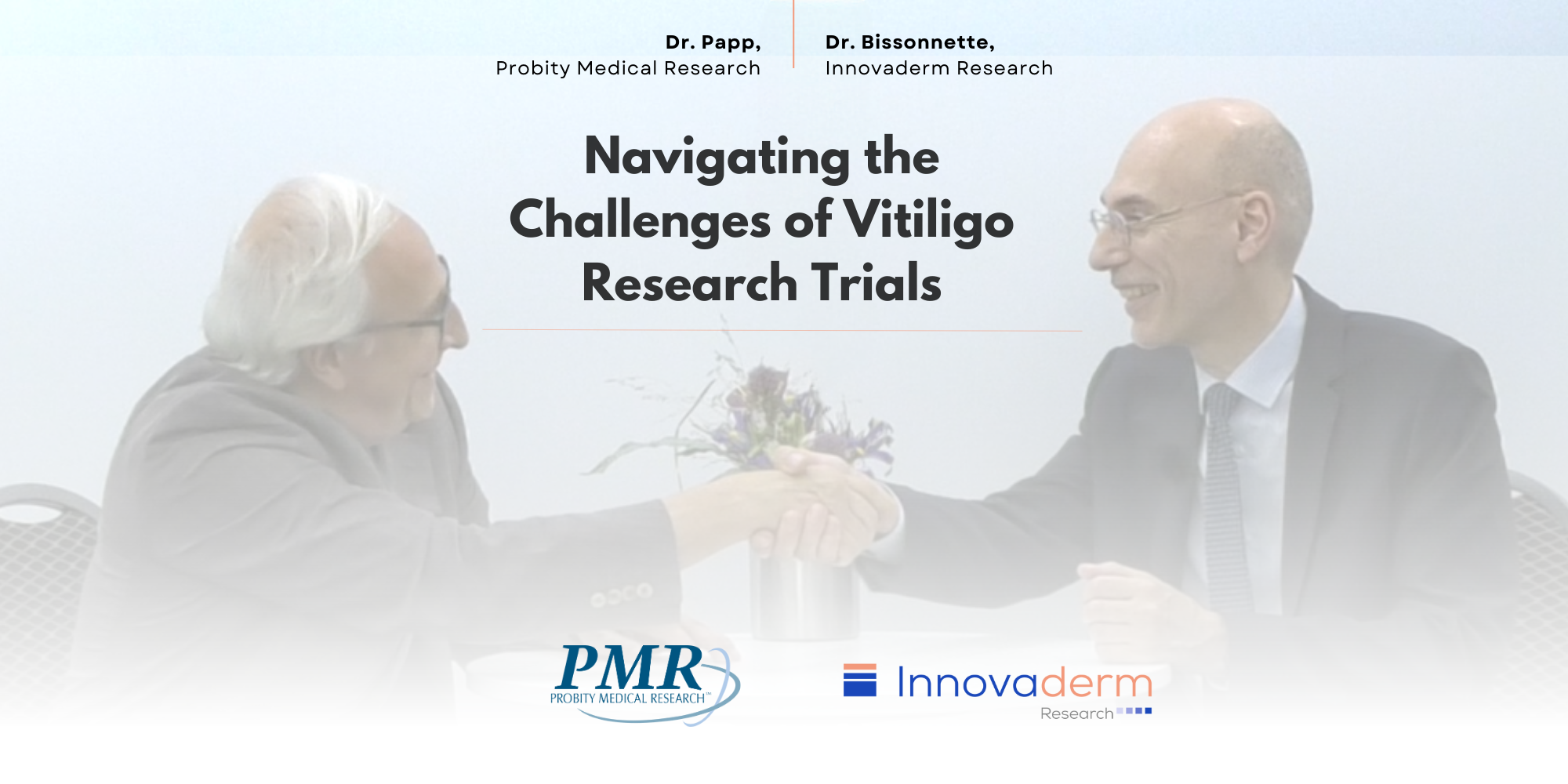Dr. Robert Bissonnette and Dr. Kim Papp on Navigating the Challenges of Vitiligo Research Trials

In collaboration with Probity Medical Research (PMR)
Dr. Bissonnette from Innovaderm Research and Dr. Papp from Probity Medical Research (PMR) took a moment between presentations at the 2023 EADV for an interesting industry talk where the duo covered the intricacies of early phase studies and some of the main challenges encountered with conducting alopecia areata (AA) studies. However, the spotlight of this article will be on vitiligo studies. This piece aims to explore the complexities and the latest advancements in vitiligo research.
Dr. Robert Bissonnette— Recently, I have observed challenges arising in certain medical indications.
Dr. Kim Papp— Certainly, particularly when considering the scarcity of vitiligo studies—fewer than 20 conducted in the last five years—there is a clear need for advancements, yet the challenge persists. Now, turning the question to you, what do you perceive as the primary challenge in designing or executing vitiligo studies?
Investigator Clinical Assessments
Vitiligo Area Index (VASI)
Dr. Robert Bissonnette— Undoubtedly, conducting studies on vitiligo poses distinctive challenges in clinical research, setting it apart as a unique and particularly demanding subject compared to many other indications, including atopic dermatitis (AD), psoriasis, and AA. The primary endpoint, the Vitiligo Area Index (VASI), both facial and total body, proves to be notably intricate. Unlike the concepts behind the Psoriasis Area and Severity Index (PASI) and the Eczema Area and Severity Index (EASI), understanding and applying VASI involve a substantial learning curve. Notably, investigators unfamiliar with vitiligo studies often need to include a small number of patients or conduct a trial to gain proficiency in its assessment.
Fitzpatrick Phototype Skin Evaluation in Vitiligo
Another challenge I have observed, drawing from my experience as an investigator, is the evaluation of vitiligo in patients with phototype 2 or light phototype 3 during winter in regions like Canada or the US. The ease of evaluation in summer contrasts starkly with the difficulties faced during the colder months. However, as more studies are conducted over time, investigators are likely to improve and refine their approaches. When considering proof-of-concept (POC) studies, it is advisable to target sites with prior experience in vitiligo studies. Undertaking a POC study with sited inexperienced in vitiligo studies poses heightened risks, although measures like central reading can be employed to mitigate these challenges.
The Unreliability of Successive Assessments in Vitiligo
Dr. Kim Papp— I share a similar perspective, though I may diverge slightly in my approach. While I believe that the VASI is inherently a competent measure, the challenge lies in its intricate and often imprecise reproduction. Estimating the degree of depigmentation, for instance discerning whether a freckle constitutes 0.1% or 0.01% among a multitude of freckles, poses a conceptual challenge that struggles in execution. Consequently, I will set aside this conceptual aspect momentarily to delve into the critical issue of data collection.
Use of Photographs and AI in Vitiligo Studies
Efficient, user-friendly, and crystal-clear data collection methods are paramount to minimizing error rates. The current landscape, with its cumbersome tablets and potential pitfalls like missing columns, demands a more streamlined and user-friendly approach. In my opinion, the most impactful solution involves removing the human element from the equation. Vitiligo presents a unique opportunity for digital measurements, leveraging artificial intelligence and photographic techniques. Utilizing tools such as wood’s light and standardized illumination, a photograph can be taken, and precise measurements can be derived with exceptional accuracy through computer analysis. This, I believe, holds the potential to make a significant difference in the accuracy and reliability of data collection for vitiligo studies.
Dr. Robert Bissonnette— I fully agree with your perspective, and as you are likely aware, several reputable photography vendors currently employ algorithms and specialized programs for these purposes, marking a significant stride toward the future of data collection in vitiligo studies. Furthermore, it is worth noting that the FDA has issued guidance documents endorsing the use of imaging technology for primary endpoints. I believe that, with continued advancements, we may eventually witness widespread adoption of these innovative approaches in clinical research.
In conclusion, navigating vitiligo studies presents unique challenges, from the complexity of evaluating using VASI and the demanding nature of data collection. As we look ahead, the integration of user-friendly, automated systems may not only enhance accuracy but support vitiligo research by paving the way for more efficient and reliable studies in the future.
Follow the link to gain access to the full interview.
Let’s shape the future of clinical research and make a difference in the industry, gain Innovaderm’s support in your upcoming trial and propel your study to new heights.
Newsletter
Newsletter subscription resources

